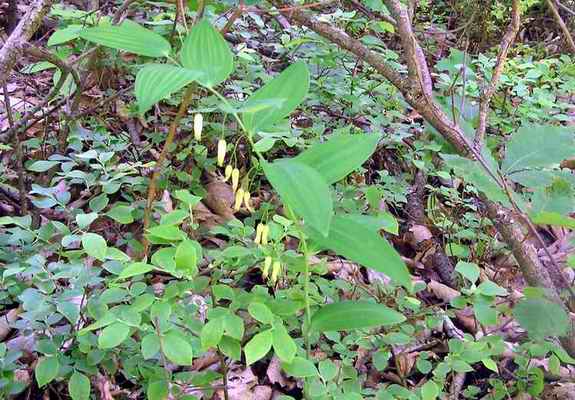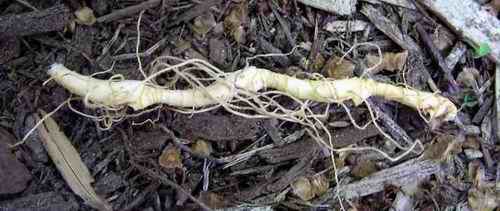|
Common Name: Solomon's Seal, Lady's Seals, St. Mary's Seal (Sigillum Sanctae Mariae in Latin), Scean de Solomon (French), Weusswurz (German) Scientific Name: Polygonatum biflorum (The generic name means many angles from the Greek poly and gonia and refers to the many angled joints of the rhizome. The species name is two-flower for the manner in which the blossoms deploy)
The name Solomon's Seal is attributed to the appearance of the cross section of the stem where it attaches to the underground root structure called the rhizome. The rhizome is actually a horizontal underground stem section from which the aboveground stem extends from the top and the real roots extend from the bottom. In the winter when the aboveground stem dies back, a cicatrix or scar is formed on the rhizome at the juncture. Since a new stem forms every year, the rhizome consists of a series of short sections attached at knots or nodes that mark the previous years growth. The number of nodes along the length can be used to determine the age of the plant, much like tree rings. The shape of the cicatrix is said to resemble the seals that were once used to seal letters with wax. The markings on the face of the cut region appear to some observers to be suggestive of Hebrew characters.
To others, the scar calls to mind the Seal of Solomon, which may be either the hexagram symbol of Israel now known as the Star of David, or to the five-pointed pentagram star that was also an early symbol of mysticism. The legend of King Solomon's Seal, which was administered with a signet ring, is shared by the three major religions of the West: Judaism, Christianity and Islam. King Solomon was the son of King David and is credited with the establishment of Jerusalem (originally named Shalem in reflection) as the city of justice and peace. He is credited with having a gift of great knowledge and wisdom, to the extent that one of the books of the Apocrypha is entitled the Wisdom of Solomon, containing didactic exhortations, commendations of wisdom, and promises of immortality. The seal therefore symbolizes god-like wisdom and cherubic grace.
The hexagram has been a symbol of cosmic balance since the Greek followers of Pythagoras noted its geometric perfection. This carried over to the Moslems, whose love of the art of geometry was manifest in the use of the hexagram as a symbolic link between science, beauty and the metaphysical world of astrology. When Sultan Suleiman the Magnificent rebuilt the Temple Mount in Jerusalem in 1536 to replace the crusader church with a mosque, he built walls around the city with stone decorations in the form of hexagrams whose function was to protect the inhabitants from the external forces of evil. In Europe, the pentagram is more commonly known as King Solomon's Seal whereas the hexagram is known as the Star of David, the symbol of the Jewish people. This association was gradual, beginning with the Jewish community in Prague in the 14th Century and extending to become associated with the nation of Israel in the 20th Century.
The powers of King Solomon's Seal in mysticism began with the use of the hexagram on magic doorpost scrolls known as mezuzot. The sign came to be thought of as a seal against the onslaught of harmful spirits. The use of the plant Solomon's Seal for a wide variety of medicinal purposes is due to the Doctrine of Signatures. This theory, which was prevalent in Europe in the 16th Century, was based on the notion that plants were "signed" by God to indicate their intended use by man. A plant that carried a symbol as powerful as the Seal of King Solomon must therefore be good for almost anything.
John Gerarde's Herbal of 1633 provided that "The root of Solomon's Seal stamped while it is fresh and greene, and applied, taketh away in one night, or two at the most, any bruise, black or blew spots gotten by falls or womens wilfulnesse, in stumbling upon their hasty husbands fists or such like." Accordingly, early colonists prepared a poultice from the root that was used to treat all types of sores and skin injuries. Some observers noted that the rhizome looked like a swollen joint and it was therefore used as a treatment for arthritis. The notion that it was a seal was taken to mean that it would be most effective in the sealing or knitting of broken bones. The flowers were used as snuff and were noted for their power to induce sneezing and to thereby relieve a headache. The berries and the leaves were chewed to induce nausea and vomiting. In modern herbal medicine, a decoction is prepared from the rhizome after it has been harvested, dried and powdered. It produces a mucilaginous tonic that has been found to be a general restorative, particularly for inflammations of the stomach and bowels. It has been reported to cure erysipelas, an acute infectious disease of the skin and the mucous membranes that is caused by a streptococcus. |

